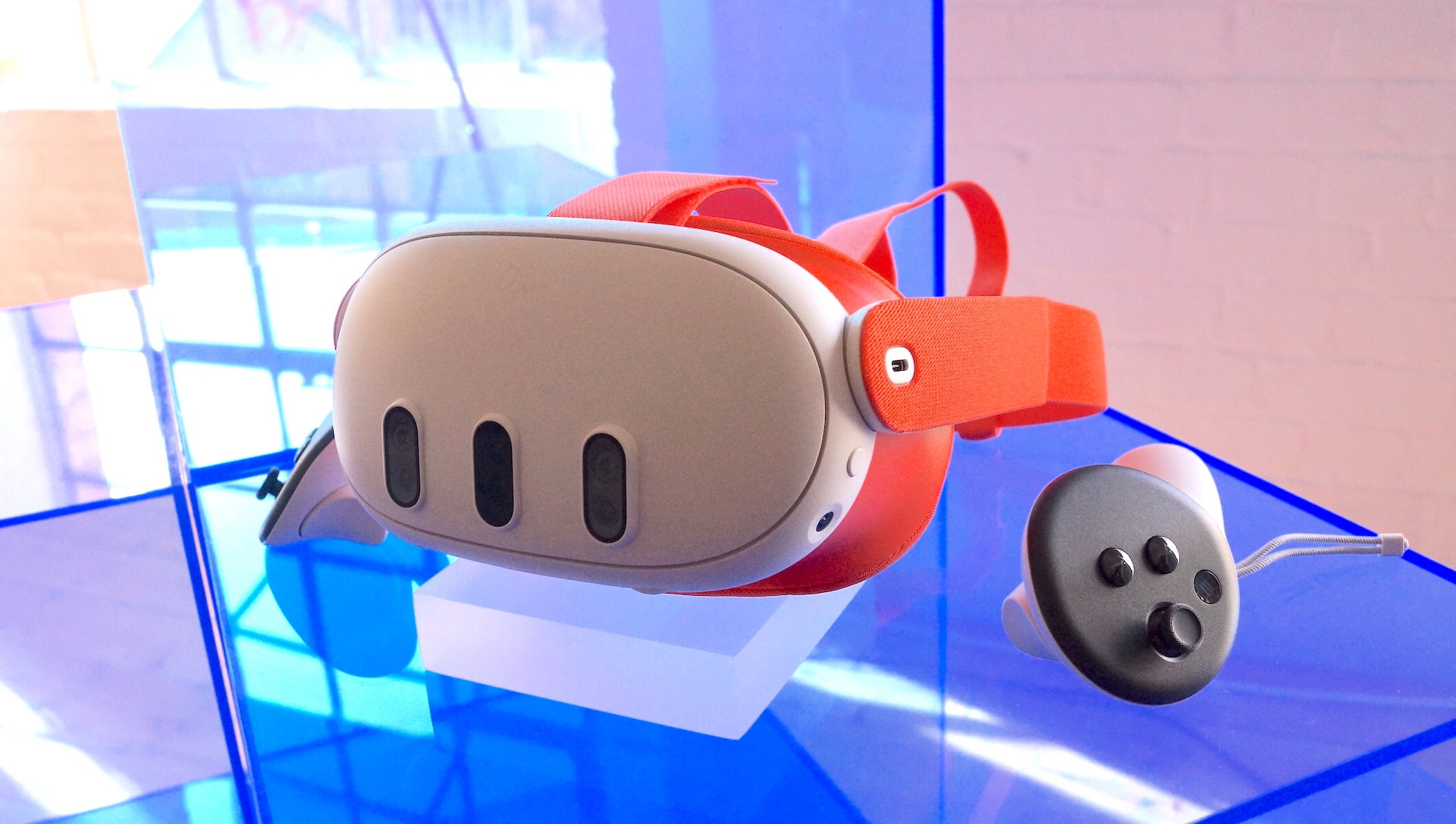First Impressions
The Meta Quest 3 looks to be a huge upgrade on its predecessor in practically every way with a more compact design, improved lenses, seriously boosted power and new mixed reality capabilities.
-
Mixed reality:Blends both the virtual and real-world space to add more variety for apps and game experiences. -
2x faster graphics than Meta Quest 2Snapdragon XR2 Gen 2 chip ensures a signifcantly faster performance for games. -
4K+ Infinite DisplayProvides close to a 30% resoluston boost compared to Meta Quest 2.
Introduction
Three years after the release of the Meta Quest 2, the Meta Quest 3 is finally here – and it’s a huge upgrade compared to its predecessor.
Sporting a more compact, lighter design with improved optics and higher-res displays, the Snapdragon XR 2 Gen 2-powered VR headset delivers some of the most impressive VR visuals of any standalone headset to date.
The headset also has a renewed focus on mixed reality (aka MR), with tech available not even present on the top-end Quest Pro that really makes MR engaging and fun.
The downside is that it’s also much more expensive than its £299 predecessor, starting at an increased £479.99 with 128GB of storage or £619.99 if you want to opt for 512GB of storage.
While I’m not yet ready to deliver my final thoughts on the Meta Quest 3, I did get the opportunity to go hands (or should that be eyes) on with the headset ahead of its reveal, and here’s what I think so far.
Design and fit
- 40% thinner HMD
- New Y-style strap
- Upgraded pancake lenses
The Meta Quest 3 is an all-round upgrade on the Quest 2, and that begins with its design. Though it looks broadly similar to its predecessor, the Quest 3 head-mounted display (HMD) is significantly smaller – 40% thinner, to be exact.
That means the headset is lighter and, with added cushioning around the edges of the HMD, it was really comfortable to have strapped to my face for almost three hours straight.
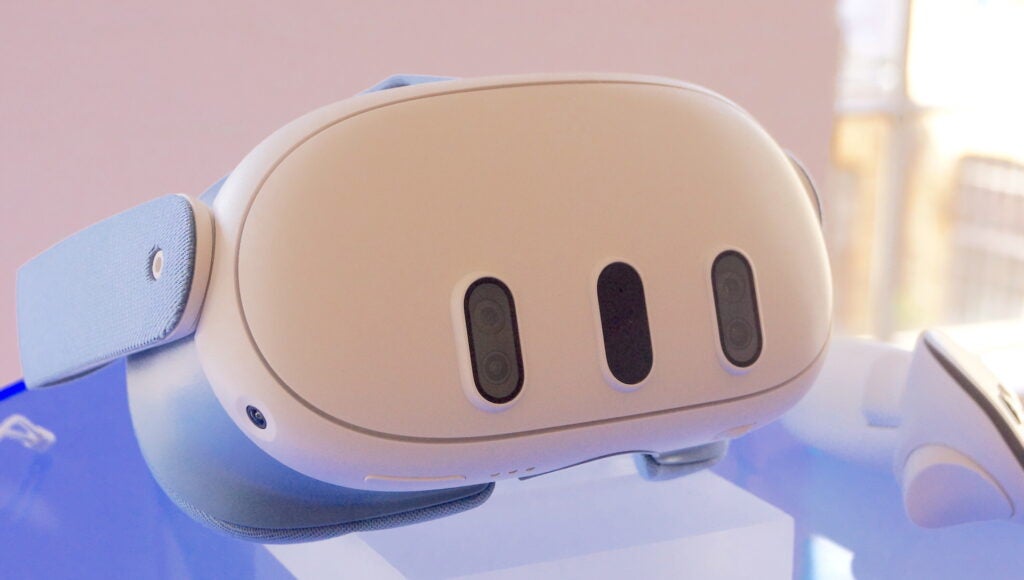
That significant reduction in size is down to the inclusion of an upgraded pancake lens system, which is not only more compact than the frenzel-based system of its predecessor but delivers much clearer optics.
Combined with a 30% increase in the resolution (now at 2064×2208 pixels per eye) of the screens found within, there’s a huge upgrade to VR and MR visuals.
Once again, the Quest 3 sports open-ear audio with stereo support, though Meta claims that it’s capable of delivering 40% louder audio than its predecessor. I can’t specifically verify that claim, but I will say that I had no issue hearing VR content in a demo hands-on area with 15+ people in the same medium-sized room.
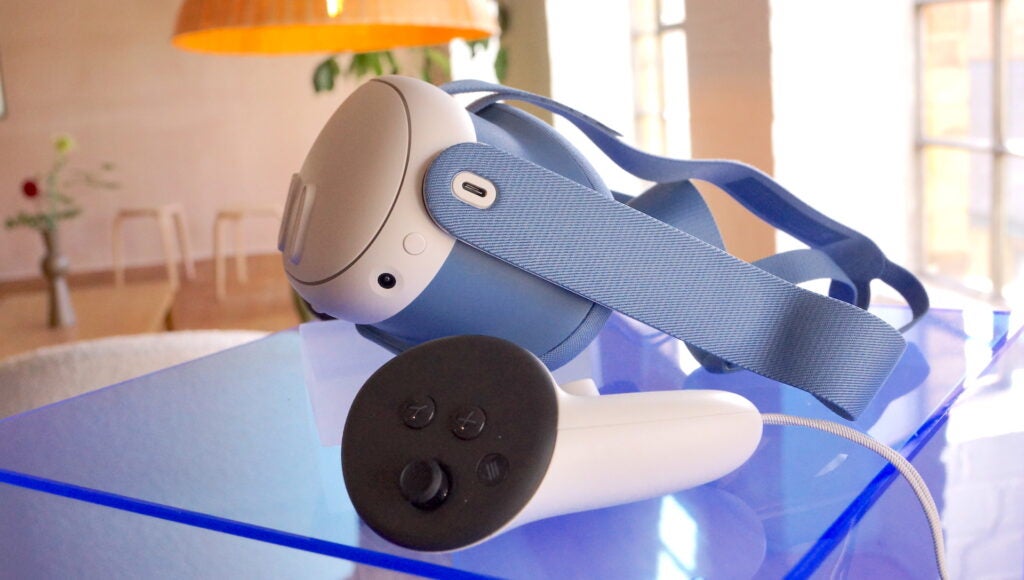
I wouldn’t say that, overall, it’s better looking than the Quest 2 – the older headset arguably has a cleaner design, lacking the three large central sensor housings of the newer model – but the thinner, lighter HMD and improved optics are certainly a huge win.
The strap has also had a redesign to match, with a new colourful Y-style fabric strap bundled in the box with other straps available to buy separately. I didn’t get a chance to use the Y-style strap during my hands-on (all demo headsets used the updated Elite strap with its crank design) but it looks like a sturdier option compared to the single over-head strap of the Quest 2.
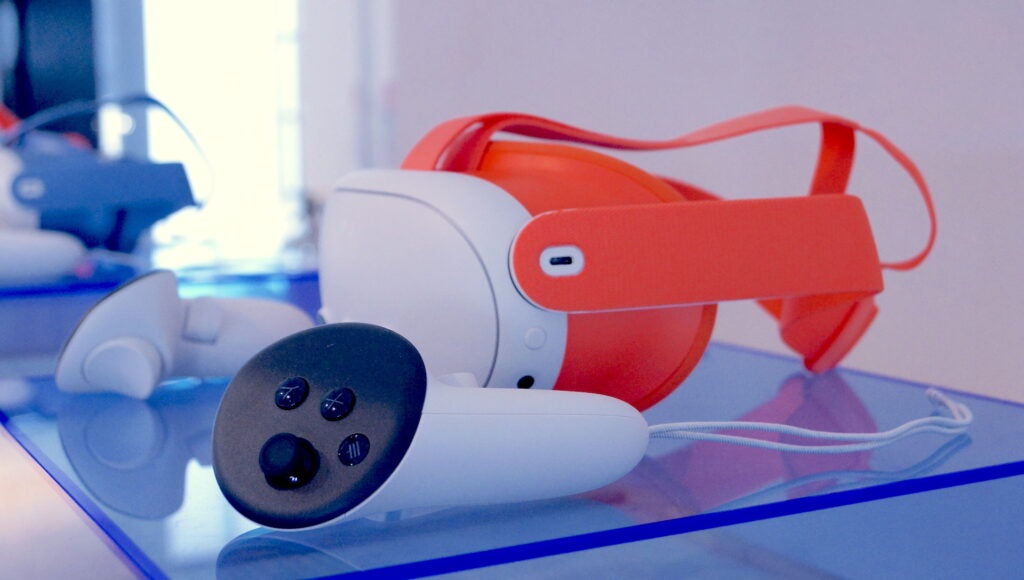
I will say that, with the Elite strap at least, the headset felt well-balanced without that front-heavy pressure you’d experience over longer sessions with the Quest 2, making for a much more comfortable fit overall. I just hope that also translates to the Y-style strap.
Controllers
- Smaller, more ergonomic shape
- No more tracking rings
- Still requires replaceable batteries
Along with a redesigned headset, the Meta Quest 3 controllers have also had a facelift.
The most notable difference is the removal of the large circular tracking ring, allowing for a much smaller, more ergonomic design while retaining access to the same controls as the Quest 2 thanks to a combination of IR LEDs and sensors.
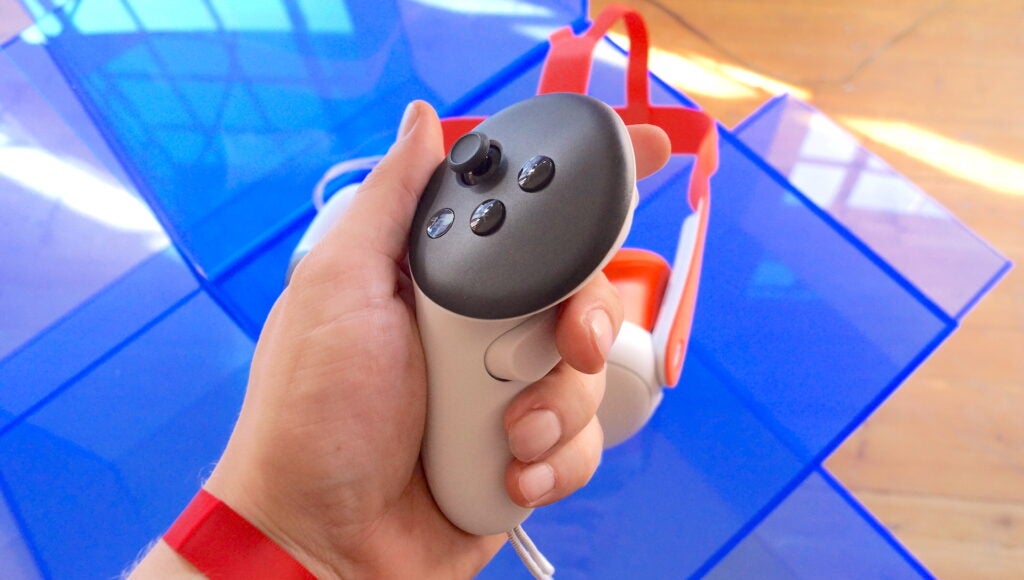
Looking at them, you might assume that they’re the same as the Quest Pro controllers, but that’s not the case. While both sport a similar look, the Quest Pro controllers are able to track their physical position without being in view of the HMD, while the Quest 3 controllers still need to be in view of the HMD to be correctly tracked.
The Quest 3 controllers also require removable batteries for power, compared to the built-in batteries of the Quest Pro controllers.
Still, they look to be a big improvement on the Quest 2 controllers with a compact design that was much easier to grip during my hands-on session.
Performance
- Powered by the Snapdragon XR 2 Gen 2 platform
- Incredible detail in VR games
- Impressive MR capabilities
While a lighter, more compact headset and redesigned controllers are great additions to the Quest offering, the real reason to opt for the Meta Quest 3 is the impressive performance on offer.
At the heart of the Quest 3, you’ll find Qualcomm’s new Snapdragon XR 2 Gen 2 Platform – the first standalone VR headset to sport the tech. The new chipset essentially doubles the processing power of the Quest 2, and when combined with the higher-res screens and pancake optics, delivers an incredible virtual experience closer to that of PCVR alternatives than ever.
That was best showcased to me during the Red Matter 2 technical showcase. It’s essentially a modded version of the full game designed to showcase the technical prowess of the new headset, and reader, I was absolutely blown away.
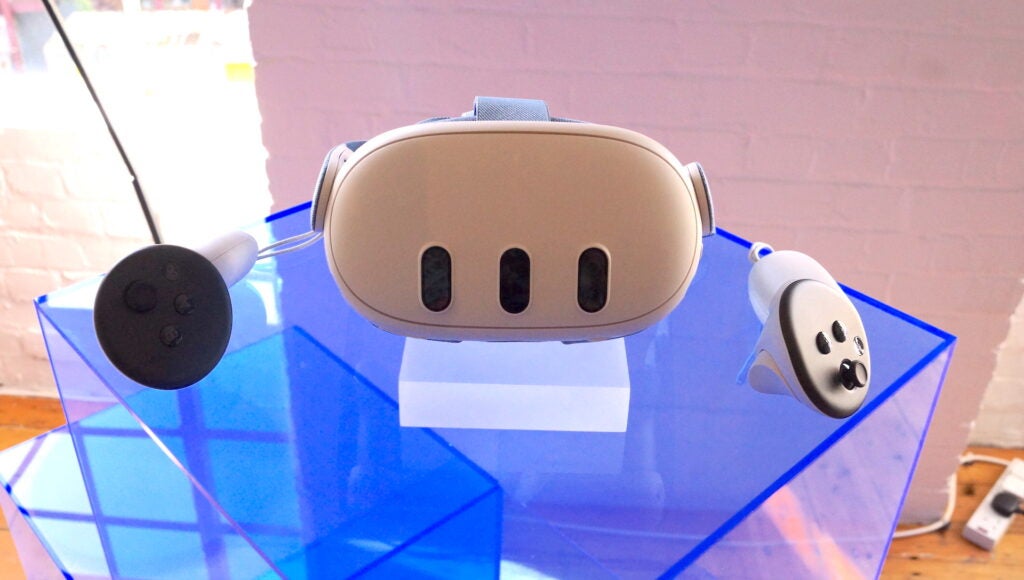
The level of detail on offer is day-and-night compared to the Quest 2 – something that was constantly drilled home with the ability to switch to a Quest 2 comparison mode with the click of the analogue stick.
The realism of Red Matter 2 was perfect for this, with even intricate details like fingerprints on a Polaroid photo and the fine smudges of residue on window panes easily visible. That also extends to text, with on-screen text easily legible without needing to get super close as with the Quest 2 and most other standalone VR headsets.
The extra processing power not only allows for higher resolution and more detailed textures, but additional dynamic elements like shadows. That might seem pretty basic, but there are few titles for the Quest 2 that do a good job of realistically rendering shadows, and it really improved the immersion I felt.
Genuinely, I still can’t quite wrap my head around just how bad it makes Red Matter 2 on the Quest 2 look in comparison, and I can’t wait to see how that translates to other titles like Blade & Sorcery: Nomad and Bonelab once I get a sample for full review.
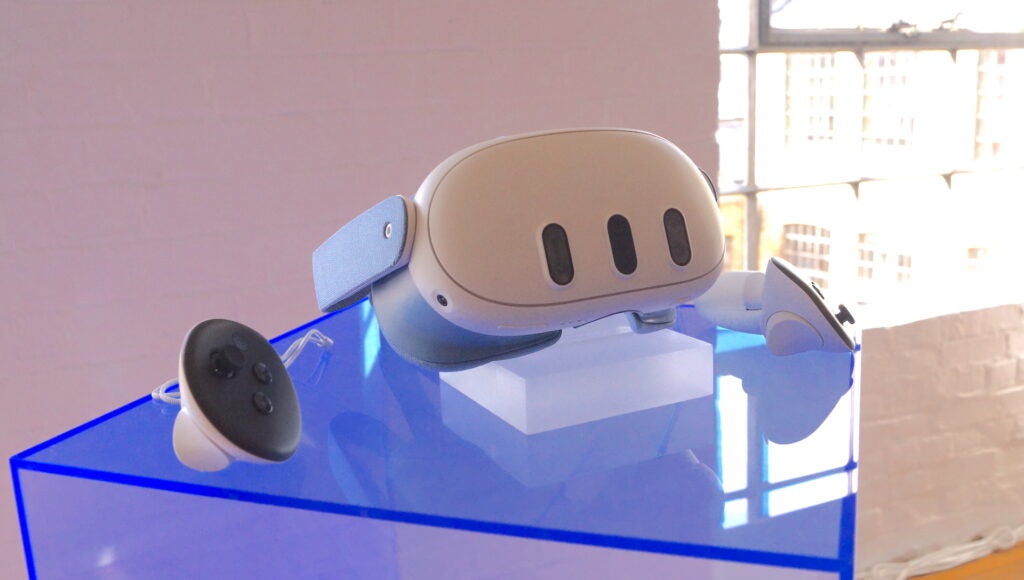
VR is only half the story when it comes to the Quest 3 – it also boasts impressive mixed reality capabilities thanks to the upgraded full-colour cameras with 10x the pixels of the Quest 2 and a new depth sensor not even seen on the top-end MR-focused Quest Pro.
That new depth sensor allows for much easier boundary creation, allowing you to simply look around the space to map it out, and with automatic room and object recognition, the headset can even map out walls, ceilings, sofas and more and bring those elements into the MR experience.
That was showcased in a First Encounters demo I played, which brought the physical environment around me into the fun. After mapping, you can shoot away the walls of your space to reveal a larger virtual world behind it – a world where small furry creatures come pouring in.
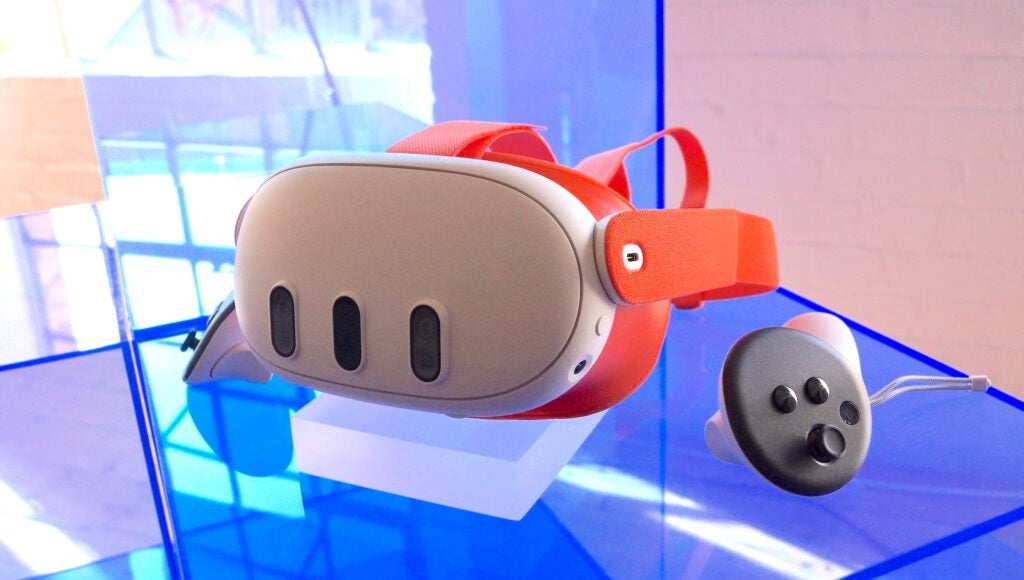
It was at that point that the fun truly began, as I was tasked with shooting as many of the critters in two minutes as possible. What made it truly remarkable was that the creatures could actually hide behind real-world objects in the room. At one point, I had to physically walk around a chair to get the shot on a particularly sneaky creature.
Content shouldn’t be a problem either, with Meta claiming that 50+ existing apps will be upgraded with MR capabilities in the near future, as well as 50+ new titles coming to the Quest 3 at launch. Together with its vast VR library, you’ll have a collection of over 500 VR and MR titles to choose from.
It’s not just limited to MR titles on the Quest Store either. The Quest 3’s software is designed around MR, with the ability to augment your physical space with virtual elements that’ll stay fixed in place over multiple play sessions in the same space.
Meta calls these spatially aware objects Augments, and they come in various forms from portals to load specific games to widgets to check the weather. iHeartRadio has also created an Augment for radio playback, and Meta is teasing more third-party Augments coming in 2024.
It seems like a cool way to augment your living room or bedroom with virtual objects, and it’s something I’m excited to test in the full review.
Battery life
- 2-3 hours of battery life
- New Battery Saver mode
- USB-C charging
With battery life taking a hit on the Meta Quest Pro, I was a little worried about what to expect with the Quest 3 – but it turns out my fears were largely unwarranted, with Meta claiming the same 2-3 hours of battery life as the Quest 2. What’s more, that can be extended by enabling the new Battery Saver mode – though that’ll come at a hit to overall performance.
You can also extend battery life without impacting performance through the use of accessories like the new Elite strap with a built-in battery, but it’s worth noting that you can’t use Quest 2 strap accessories with the Quest 3 due to redesigned audio arms.
Charging is done via a side-mounted USB-C port just like the Quest 2, though specific charge speeds are yet to be revealed.
Early thoughts
The Meta Quest 3 looks to be a huge upgrade on its predecessor in practically every way with a more compact design, improved lenses, seriously boosted power and new MR capabilities that could change how you use the headset.
My biggest concern is that the higher price, compared to the Quest 2, could be a roadblock for many, but this is otherwise a pretty tempting standalone VR headset. Check out our Best VR Headset guide for more options.
First Impressions
The Meta Quest 3 looks to be a huge upgrade on its predecessor in practically every way with a more compact design, improved lenses, seriously boosted power and new mixed reality capabilities.
-
Mixed reality:Blends both the virtual and real-world space to add more variety for apps and game experiences. -
2x faster graphics than Meta Quest 2Snapdragon XR2 Gen 2 chip ensures a signifcantly faster performance for games. -
4K+ Infinite DisplayProvides close to a 30% resoluston boost compared to Meta Quest 2.
Introduction
Three years after the release of the Meta Quest 2, the Meta Quest 3 is finally here – and it’s a huge upgrade compared to its predecessor.
Sporting a more compact, lighter design with improved optics and higher-res displays, the Snapdragon XR 2 Gen 2-powered VR headset delivers some of the most impressive VR visuals of any standalone headset to date.
The headset also has a renewed focus on mixed reality (aka MR), with tech available not even present on the top-end Quest Pro that really makes MR engaging and fun.
The downside is that it’s also much more expensive than its £299 predecessor, starting at an increased £479.99 with 128GB of storage or £619.99 if you want to opt for 512GB of storage.
While I’m not yet ready to deliver my final thoughts on the Meta Quest 3, I did get the opportunity to go hands (or should that be eyes) on with the headset ahead of its reveal, and here’s what I think so far.
Design and fit
- 40% thinner HMD
- New Y-style strap
- Upgraded pancake lenses
The Meta Quest 3 is an all-round upgrade on the Quest 2, and that begins with its design. Though it looks broadly similar to its predecessor, the Quest 3 head-mounted display (HMD) is significantly smaller – 40% thinner, to be exact.
That means the headset is lighter and, with added cushioning around the edges of the HMD, it was really comfortable to have strapped to my face for almost three hours straight.

That significant reduction in size is down to the inclusion of an upgraded pancake lens system, which is not only more compact than the frenzel-based system of its predecessor but delivers much clearer optics.
Combined with a 30% increase in the resolution (now at 2064×2208 pixels per eye) of the screens found within, there’s a huge upgrade to VR and MR visuals.
Once again, the Quest 3 sports open-ear audio with stereo support, though Meta claims that it’s capable of delivering 40% louder audio than its predecessor. I can’t specifically verify that claim, but I will say that I had no issue hearing VR content in a demo hands-on area with 15+ people in the same medium-sized room.

I wouldn’t say that, overall, it’s better looking than the Quest 2 – the older headset arguably has a cleaner design, lacking the three large central sensor housings of the newer model – but the thinner, lighter HMD and improved optics are certainly a huge win.
The strap has also had a redesign to match, with a new colourful Y-style fabric strap bundled in the box with other straps available to buy separately. I didn’t get a chance to use the Y-style strap during my hands-on (all demo headsets used the updated Elite strap with its crank design) but it looks like a sturdier option compared to the single over-head strap of the Quest 2.

I will say that, with the Elite strap at least, the headset felt well-balanced without that front-heavy pressure you’d experience over longer sessions with the Quest 2, making for a much more comfortable fit overall. I just hope that also translates to the Y-style strap.
Controllers
- Smaller, more ergonomic shape
- No more tracking rings
- Still requires replaceable batteries
Along with a redesigned headset, the Meta Quest 3 controllers have also had a facelift.
The most notable difference is the removal of the large circular tracking ring, allowing for a much smaller, more ergonomic design while retaining access to the same controls as the Quest 2 thanks to a combination of IR LEDs and sensors.

Looking at them, you might assume that they’re the same as the Quest Pro controllers, but that’s not the case. While both sport a similar look, the Quest Pro controllers are able to track their physical position without being in view of the HMD, while the Quest 3 controllers still need to be in view of the HMD to be correctly tracked.
The Quest 3 controllers also require removable batteries for power, compared to the built-in batteries of the Quest Pro controllers.
Still, they look to be a big improvement on the Quest 2 controllers with a compact design that was much easier to grip during my hands-on session.
Performance
- Powered by the Snapdragon XR 2 Gen 2 platform
- Incredible detail in VR games
- Impressive MR capabilities
While a lighter, more compact headset and redesigned controllers are great additions to the Quest offering, the real reason to opt for the Meta Quest 3 is the impressive performance on offer.
At the heart of the Quest 3, you’ll find Qualcomm’s new Snapdragon XR 2 Gen 2 Platform – the first standalone VR headset to sport the tech. The new chipset essentially doubles the processing power of the Quest 2, and when combined with the higher-res screens and pancake optics, delivers an incredible virtual experience closer to that of PCVR alternatives than ever.
That was best showcased to me during the Red Matter 2 technical showcase. It’s essentially a modded version of the full game designed to showcase the technical prowess of the new headset, and reader, I was absolutely blown away.

The level of detail on offer is day-and-night compared to the Quest 2 – something that was constantly drilled home with the ability to switch to a Quest 2 comparison mode with the click of the analogue stick.
The realism of Red Matter 2 was perfect for this, with even intricate details like fingerprints on a Polaroid photo and the fine smudges of residue on window panes easily visible. That also extends to text, with on-screen text easily legible without needing to get super close as with the Quest 2 and most other standalone VR headsets.
The extra processing power not only allows for higher resolution and more detailed textures, but additional dynamic elements like shadows. That might seem pretty basic, but there are few titles for the Quest 2 that do a good job of realistically rendering shadows, and it really improved the immersion I felt.
Genuinely, I still can’t quite wrap my head around just how bad it makes Red Matter 2 on the Quest 2 look in comparison, and I can’t wait to see how that translates to other titles like Blade & Sorcery: Nomad and Bonelab once I get a sample for full review.

VR is only half the story when it comes to the Quest 3 – it also boasts impressive mixed reality capabilities thanks to the upgraded full-colour cameras with 10x the pixels of the Quest 2 and a new depth sensor not even seen on the top-end MR-focused Quest Pro.
That new depth sensor allows for much easier boundary creation, allowing you to simply look around the space to map it out, and with automatic room and object recognition, the headset can even map out walls, ceilings, sofas and more and bring those elements into the MR experience.
That was showcased in a First Encounters demo I played, which brought the physical environment around me into the fun. After mapping, you can shoot away the walls of your space to reveal a larger virtual world behind it – a world where small furry creatures come pouring in.

It was at that point that the fun truly began, as I was tasked with shooting as many of the critters in two minutes as possible. What made it truly remarkable was that the creatures could actually hide behind real-world objects in the room. At one point, I had to physically walk around a chair to get the shot on a particularly sneaky creature.
Content shouldn’t be a problem either, with Meta claiming that 50+ existing apps will be upgraded with MR capabilities in the near future, as well as 50+ new titles coming to the Quest 3 at launch. Together with its vast VR library, you’ll have a collection of over 500 VR and MR titles to choose from.
It’s not just limited to MR titles on the Quest Store either. The Quest 3’s software is designed around MR, with the ability to augment your physical space with virtual elements that’ll stay fixed in place over multiple play sessions in the same space.
Meta calls these spatially aware objects Augments, and they come in various forms from portals to load specific games to widgets to check the weather. iHeartRadio has also created an Augment for radio playback, and Meta is teasing more third-party Augments coming in 2024.
It seems like a cool way to augment your living room or bedroom with virtual objects, and it’s something I’m excited to test in the full review.
Battery life
- 2-3 hours of battery life
- New Battery Saver mode
- USB-C charging
With battery life taking a hit on the Meta Quest Pro, I was a little worried about what to expect with the Quest 3 – but it turns out my fears were largely unwarranted, with Meta claiming the same 2-3 hours of battery life as the Quest 2. What’s more, that can be extended by enabling the new Battery Saver mode – though that’ll come at a hit to overall performance.
You can also extend battery life without impacting performance through the use of accessories like the new Elite strap with a built-in battery, but it’s worth noting that you can’t use Quest 2 strap accessories with the Quest 3 due to redesigned audio arms.
Charging is done via a side-mounted USB-C port just like the Quest 2, though specific charge speeds are yet to be revealed.
Early thoughts
The Meta Quest 3 looks to be a huge upgrade on its predecessor in practically every way with a more compact design, improved lenses, seriously boosted power and new MR capabilities that could change how you use the headset.
My biggest concern is that the higher price, compared to the Quest 2, could be a roadblock for many, but this is otherwise a pretty tempting standalone VR headset. Check out our Best VR Headset guide for more options.


















